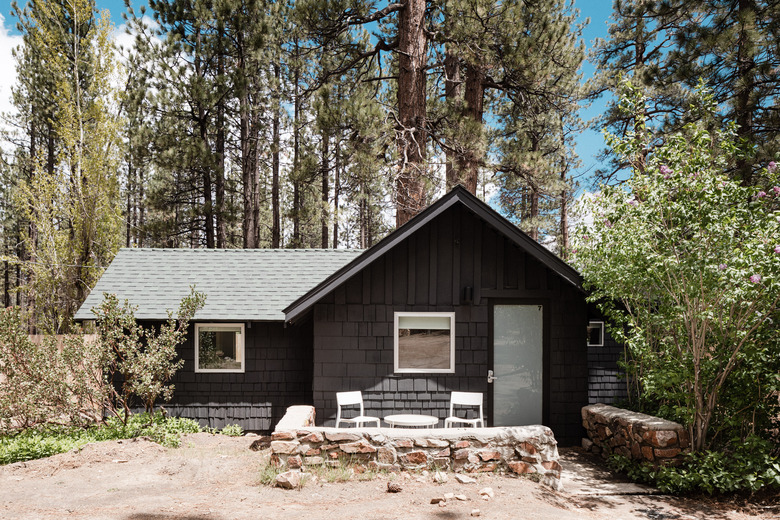A Beginner's DIY Guide To Planting Trees
We may receive a commission on purchases made from links.
Planting trees is a good thing, and the more people who learn how to plant trees — and actually do it — the better off everyone will be. Scientists and nonscientists alike have long understood the fact clearly stated by President Franklin Delano Roosevelt, who said (as quoted by the Amazon Aid Foundation): "Forests are the lungs of our land, purifying the air and giving fresh strength to our people." Large trees can each absorb 48 pounds of carbon dioxide from the atmosphere every year and replace it with oxygen, and a single large tree provides a day's worth of oxygen for four people, according to the Arbor Day Foundation. Trees also provide shade and a home for wildlife, they help clean the water and remove pollutants from the air and they increase property values.
If you're new to planting trees, you might think there's a lot to learn, but the procedure is actually pretty simple as long as you remember that you're handling a living being. You need to plant during an appropriate season, and you need to put the tree in a location in which it has room to grow and has all the water and nutrients it needs to thrive. Apart from that, all you need to do to plant a tree is dig a hole big enough for the root ball, backfill with native soil, spread mulch and water regularly until the tree gets established.
Best Time for Planting Trees
Best Time for Planting Trees
For people living in tropical and semitropical climates, virtually any time of year is a good time to plant trees, but for people who live in more temperate climates with freezing temperatures — which is most people in North America — some seasons are better than others. For obvious reasons, the dead of winter is not a good time, but midsummer can be just as bad for some trees. That's the time of year when plants are at their most vibrant, and not every tree can split its energy between producing new growth and establishing new roots in a healthy way.
Trees experience transplant shock when transferred from one place to another or from a container to the ground, and they may lose leaves and grow at a reduced rate until the roots are well-enough established to extract nutrients from the soil. This makes late autumn after the leaves fall the best time to plant a new tree, especially a deciduous one because it's about to go dormant and will have the entire winter to establish its roots in preparation for a growth spurt in the spring. Early spring before the buds form is also a good time for planting trees.
When it comes to conifers, the New York Botanical Garden.) advises planting them in the early spring (from March to May) or early fall (from September to October). They don't go dormant, and both plant and root growth continue through the winter months.
Where to Plant Trees
Where to Plant Trees
When assessing a site for a tree, the first factor to consider is the tree itself, and that starts with its ideal growing conditions, including climate, sunlight and soil requirements. The United States Department of Agriculture hardiness zone information for every species is readily available, and if you live in a zone other than the ones in which your chosen tree can survive, it's best to choose another type of tree.
Sunlight requirements are also important. Some trees need full sun for at least six hours a day, while others can tolerate partial or full shade. Finally, consider soil and moisture requirements because a tree that needs well-draining soil and little water probably won't survive in a yard that floods regularly, and a tree that loves water won't last long on an arid slope or a hillside so steep that water has no chance of soaking in.
Take the mature dimensions of the tree into account when placing it because in a few years, the sapling you have in your hands now will be much bigger. You don't want it to encroach on your house or garden, and you don't want it to grow into overhead power lines. If you're planting more than one tree, make sure to space them far enough apart to prevent either one of them from encroaching on the other.
It's a good idea to get a map of underground sewer lines so you can keep your trees far enough away to prevent tree roots from growing into the pipes and blocking them. If you have a septic system, trees should be no closer than a distance equal to the height of the adult tree or a minimum of 25 feet, as recommended by Virginia Cooperative Extension. Call an underground utility locate service to mark the ground above buried pipes or cables with paint or flags before digging. In most areas, failure to do this may result in hefty fines plus repair/replacement costs if you sever a utility pipe or cable.
How to Plant Trees Step By Step
How to Plant Trees Step By Step
Depending on size, trees come from the nursery in containers or with their roots bound by burlap or a wire basket. Just above the root ball at the base of the tree, the point at which the exposed trunk widens before becoming part of the root system is known as the trunk flare or root flare. The International Society of Arboriculture advises that this needs to be partially visible above ground when you're finished backfilling the hole in which you plant the tree.
1. Dig a Hole
Measure the diameter of the root ball with a tape measure and dig the hole to that exact depth and to a width three times that measurement using a round-point shovel. If the tree is in a container, dig the hole to the depth of the container and about three to four times as wide. The sides of the hole should slope inward to allow water to flow in the direction of the roots. Put the dirt next to the hole or into a wheelbarrow. You'll need it for backfilling.
2. Check the Depth of the Hole
Set the root ball or the container in the hole and check the depth by laying your shovel across the hole and noting the position of the trunk flare relative to the shovel handle. The top of the root ball or the container should just touch the handle, and the trunk flare should be just above it.
Because dirt can settle after planting, Growing a Greener World recommends adding dirt to the bottom of the hole to bring 25 percent of the root ball above ground and then tapering the backfill to create a mound. This is an especially good practice if you're planting in loose, loamy soil.
3. Unpack the Tree
Remove the burlap sack or wire basket covering the root ball or remove the tree from the container. If the tree doesn't come out of the container easily, lay the tree flat and tap the container or push the root ball through one of the drainage holes to loosen it. Don't try to pull out the tree by the trunk or you could separate the trunk from the roots.
4. Separate the Tree's Roots
You often find roots growing in clusters on the outside of the root ball, and if the tree was in a container, the root system will be growing in the shape of the container. It's crucial to separate the roots so they can spread out, or the tree will not realize its full potential and may even die.
If the root ball is crumbly enough, you can remove soil with your fingers and gently stretch out each bare root individually, but as often happens with a new tree in a container, the root ball may be compacted. In that case, use a sharp knife to cut an "X" in the bottom of the root ball as well as four lines along the sides. Then, use the knife to dig out as much dirt as possible and stretch out the roots by hand.
5. Set the Tree in the Hole
Lower the tree into the hole and straighten it, getting a helper if necessary to verify that it's straight. Backfill the hole with the dirt you dug out of it. Do not backfill with topsoil or planting mix and do not amend the soil before backfilling unless you plan to amend the surrounding soil in which roots will grow. If you amend only a small portion of the soil, the roots will grow preferentially in that area and won't spread out, and that will stunt the tree's growth.
Staking a new tree generally isn't recommended, according to Fine Gardening, because it prevents the trunk from moving and strengthening on its own, but if the new roots are too small to support the trunk, staking may be necessary. Use twine or stretch tie tape to tie the tree loosely enough to avoid girdling but tightly enough to prevent the tree from rubbing against the stake and suffering wounds that may not heal.
6. Get Rid of Air Pockets
Backfill the planting hole about halfway and spray the sides with a garden hose. The water will flow into the hole and compress the earth while giving the new tree a good drink. Spray water to get rid of air pockets that can hinder growth by providing spaces in which roots get no nourishment.
7. Continue Backfilling
Pack dirt into the hole, tamping and spraying water as you go to get rid of air pockets until you reach ground level. At this point, the root flare should be exposed. If you raised the root system above ground, backfill until all the roots are covered and only the root flare is visible.
8. Add Mulch
Spread a 2-inch layer of organic material, such as wood chips, old leaves or bark, on the ground around the young tree, leaving a 2- or 3-inch space around the trunk. Mulching keeps moisture in the ground, and it protects the young roots from heat, sunlight and freezing temperatures.
9. Water Regularly Until the Tree Is Established
New trees need deep, slow watering to help their roots get established. You can do this with a garden hose, but it's more efficient to set up a soaker hose or a drip system because they deliver water slowly enough for the roots to absorb it. For the first week or so, the tree will need water every day, but after that, you can cut back to every other day and ease off from there.
Overwatering is just as harmful to the tree as not watering enough. If the soil doesn't drain quickly enough, the roots can rot, or the tree can literally drown, so pay attention to how well the tree is responding and reduce the water if it seems to be doing poorly. On the other hand, you'll want to increase the watering if the leaves turn brown and fall off after the initial stress period (during which this is normal) has passed.
References
- Amazon Aid Foundation: 9 Inspiring Quotes About Forests
- Arbor Day Foundation: Tree Facts
- New York Botanical Garden: Conifers: Planting and Maintenance: Home
- Virginia Cooperative Extension: Planting on Your Septic Drain Field
- Growing a Greener World: How to Plant a Tree the Right Way – 7 Steps for Getting it Right Every Time
- International Society of Arboriculture: Planting a Tree

